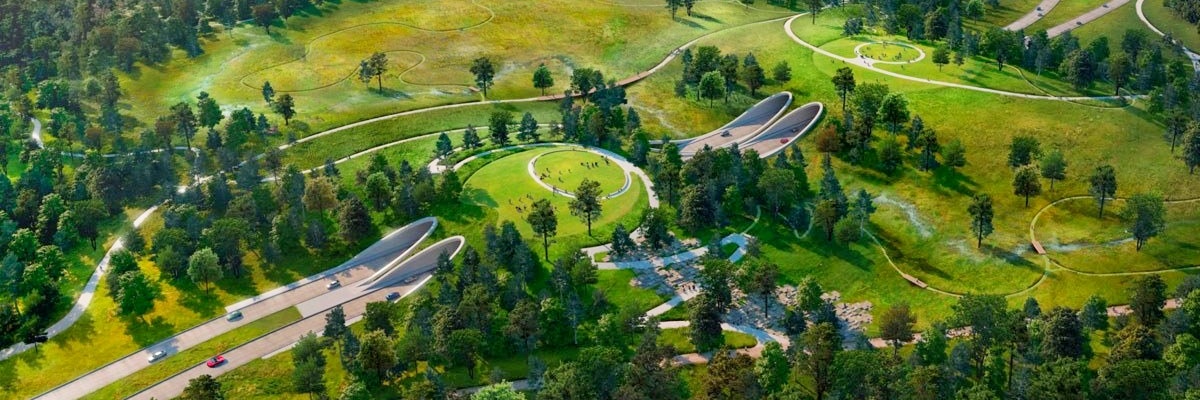Reprinted with Permission from the March/April 2024 Texas Architect
By Lauren Woodward Stanley, AIA
Improved microclimates are critical for climate adaptation, health, and connectivity.
I.
… it’s like, you know in the Wizard of Oz, when Dorothy meets the Scarecrow and they do that little dance at that crossroads and they think about going all those directions and they end up going in that one direction—I mean, all those other directions … became separate realities … entirely different movies, but we’ll never see it because we’re kind of trapped in this one reality restriction type of thing you know …
In the opening scene of Slacker, writer-director-actor Richard Linklater’s character holds forth to a captive cab driver as they leave the Austin Mueller airport and cruise through the early morning dusk. His reality-curious stream of consciousness sets the narrative meander of the film. We watch as the baton is passed between characters, tracing a serendipitous line between people, places, and weird conversations. What emerges is a sense of the web we weave across an urban canvas—a web of interaction and experience that reveals the city’s true colors. It’s a rambling portrait of Austin in the early 1990s and a story about the drive for connection.
Stories are foundational to understanding our lives and the places in which we live them. They can help us navigate a changing world. “We Need More Connection” might be the most compelling story to tell right now. The global pandemic gave us an indelible experience of personal and social disconnection. An increasing wealth gap, displaced populations, and divided cultural identities all embody disconnection within our societies. Environmental degradation and a climate veering off course reflect our disconnection from the natural world. We need to reverse this trend by first understanding that our well-being does not exist in a state of separateness and then exploring how to restore connection to each other, to ourselves, to nature.
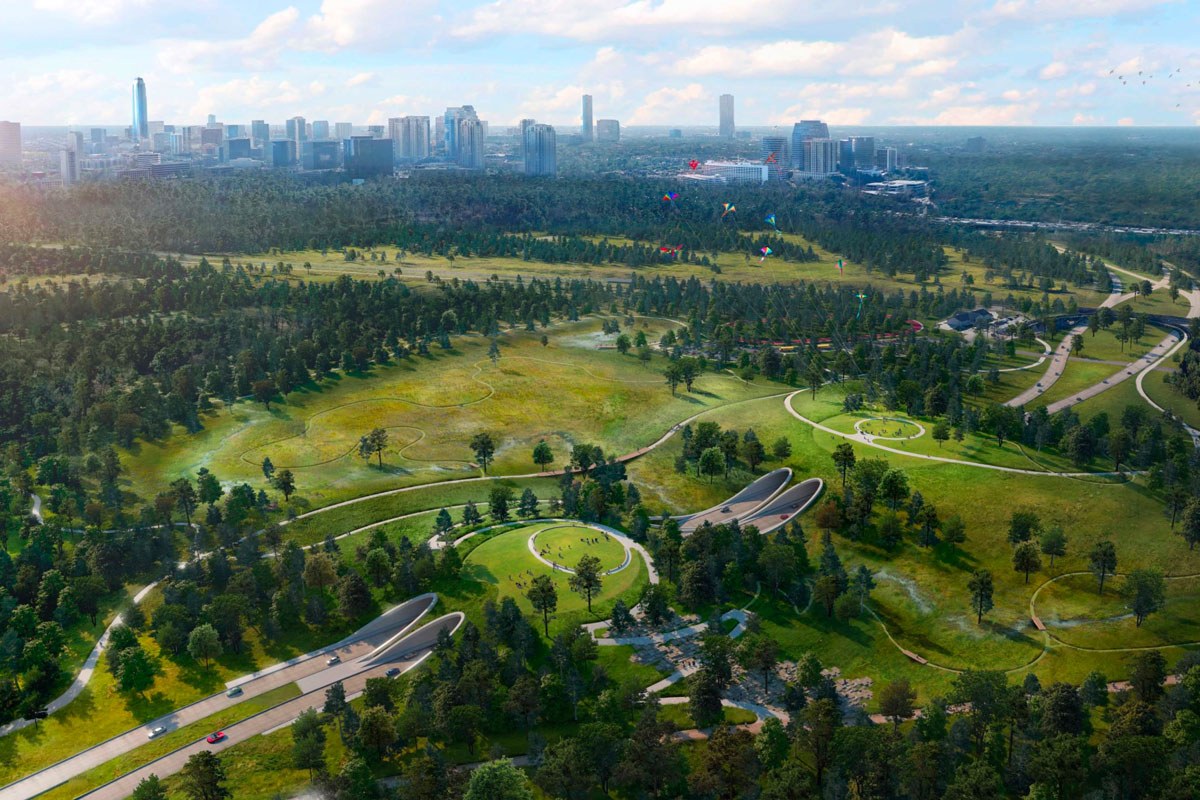
Memorial Park Land Bridge and Prairie in Houston. Image: Courtesy Memorial Park Conservancy
We might as well walk through—it’s on the way to where we’re going.
“Designing for nature and the built environment to seamlessly merge with living green architecture is a win win for all of our species. Creating biophilic microclimates with vegetated blankets, sponges, and stitches are essential to combat regional biodiversity loss and climate change and just part of a comprehensive plan to restore the health of our planet.” ~
Linda S. Velazquez, Greenroofs.com Founder & Publisher
In that same Slacker era, I found myself in Austin on the University of Texas campus visiting a friend who suggested passing through Goldsmith Hall on our walk. Ambivalent, but applying to architecture schools at the time, I agreed. The loud buzz of The Drag gave way to the hush and scent of an old building that I later came to know well. A central courtyard with palms and a stone fountain popped into view as we strolled through the glazed hallway. Fossilized masonry, which I later came to know as Cordova Shell limestone, told tiny stories from the mass of the building. These details changed everything. I added UT to my list, was accepted, and then attended. A simple connecting walk and the power of an evocative green oasis, along with the tactility of ancient stone, profoundly shifted my path. This was a kinetic encounter and connection to place. (For more on walks of encounter, see my article “The Drift” in the March/April 2021 issue of Texas Architect.)
Becoming more connected leads to health, and health should be our preeminent value and mission in an uncertain future. It could, in fact, be argued that, in this turbulent world, livability is starting to conflate with living. What it takes to survive converges with what it means to thrive. Clean water and air, green space, defensible habitation, the ability to move freely, and equitable access to these natural resources underpin both survival and optimal health, in turn leading to a sense of community and beauty. Quality of life begins with quality of earth. We are our ecology, and the sooner we fit our prevailing cultural narratives to the notion that our health is inextricably connected to the health of natural systems, the better.
Nature is a key ingredient in building the strong connective tissue that makes a city vibrant, resilient, and healthy. Its presence is critical in response to the increasing threats of climate change. Extreme heat, extreme cold, drought, flooding, fire, acute weather events, and creeping new normals demand buffering strategies to mitigate their impacts. With the integration of nature-based solutions at every scale, we can weave a finer grain of green into the city to create a more livable urban fabric. Essentially, we can make microclimates to address the larger climate. We need investments of creativity, commitment, and resources to plow into alternative kinds of infrastructure: green, blue, regenerative, biodiverse. This paradigmatic approach is created for and by many—humans and nonhumans alike—and it generates collateral benefits like species preservation, social capital, and beauty.
I just feel like the challenge of beauty ought to be everyone’s challenge. —Roberta Crenshaw, chair of the Austin Parks Board, in Origins of a Green Identity, a Living Springs documentary
So how do we make microclimates? To offer a metaphor, we make more blankets, sponges, and stitches—for protection, reservoir, and connection. We include vertical connectivity to what is above and below us. This is a story about layering up, as if to compensate for our damaged atmosphere, and about invisible, undervalued subsurface life—roots, soil, aquifers. We implement natural systems to do the heavy lifting, since they are typically generative, redundant, and cost-effective. Growing and installing canopies, overstories, understories, and screens, we shade ourselves from the hot sun, filter and temper air, collect and channel moisture. By breaking up hard surfaces, we bring texture to buildings and porosity to the ground plane, which allows infiltration by and sequestration of water, setting off a chain of environmental actions that mimic the hydrologic cycle. We create green connectivity with pathways and pauses, networks of routes and nodes. Slowing, shielding, sequestering, and funneling in this way allows us to make more environments that contribute to well-being. In dealing with catastrophic urban heat, these pocket climates may even preserve life for those without homes. These interventions are essential amenities to urban life. They are simultaneously site-responsive strategies for future-proofing our habitable space and places of health, community, art, and beauty.
What can we look to for models and lessons? From green streets to rewilded channels, there are opportunities at every scale to cool, thicken, and bring vitality to hot, flat, obdurate spaces. Some are more path-oriented, some are more place-oriented, but all are living spaces. Every city has some, and every city can create more of them. The following are some stories from the field.
II.
You’ve heard what peak oil is, right? The other day a friend of mine said he thought Austin was reaching peak quality of life. —Overheard at a local coffee shop
In Austin…
Austin has long boasted one of the country’s best urban canopies. With the recent pressures of growth and a warming climate, its current tree cover of approximately 41 percent is not secure; yet it is precisely what we need to combat extreme heat. Resident author Jeff Goodell, in The Heat Will Kill You First, warns that summers like the past one are not a flash in the pan but harbingers. Trees are ecological workhorses and the best singular solution for coping with urban heat (which both compounds and is compounded by drought). They stand to play a big role in the future livability of a city that once topped the “Most Livable” list. In particular, trees at margins and right-of-ways not only shade corridors but may factor significantly in preserving the urban canopy.
Street trees are not so easy to do. Utility dedications are a major hurdle. Continuous subsurface planters (done successfully at Dell Medical Center), good soil quality and volume, and reliable watering are difficult to achieve. Surprisingly, city code requires private development to install trees on only roughly 4 percent of city streets. Of those, most don’t make it into the ground at all. Onerous license agreements that the city currently requires of developers, among other reasons, result in the easiest course of action being to secure waivers from installing trees altogether, explains Kevin Howard, cofounder of Urbinden Design Lab, in the Planetizen article “Street Trees as Climate Resilience.” Yet this green infrastructure is more critical than ever and aligns with the city’s vision, climate, and transit plans. A new resolve is underway to elevate its importance and streamline regulatory processes. Work on the city’s Functional Green landscape code resumed last year to hone it into an effective new ordinance to green heavy-footprint projects; its stakeholder working group sees street-front trees as carrying the highest ecological potential in high-density areas. If synergies can be found between this program, proposed city resolutions promoting street trees and updating zoning, reinvigorated “complete” street efforts, and strong leadership, Austin can overcome stubborn challenges to plant needed canopy in the most dependable real estate in a rapidly developing city.
In Salt Lake City…
Taking street trees to another level of green connectivity, Salt Lake City’s Green Loop seeks to create a climate-responsive, multimodal pathway circumscribing downtown. Currently in planning and design, the project re-envisions the city’s broad streets as more hospitable, vegetated, and culturally active spaces for circulating. In a strategic gesture, project leaders brought the vision to life in early summer of 2023 through a temporary installation on a segment of the proposed route. A lively video tells the project story through lived experience, showing people walking, talking, resting, and enjoying food, art, and music. Over one thousand large, bagged trees were brought to populate zones within the street’s girth. This engaging pop-up blended a concept study with a block party, and citizen surveys are helping shape the design as a people-infused, mobility-accommodating, cooling piece of infrastructure.
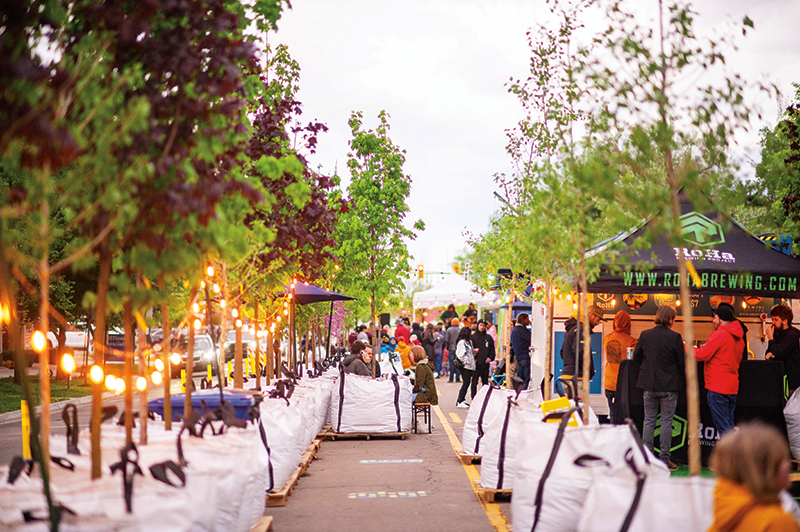
One thousand bagged trees for a Salt Lake City pop-up, David Newkirk courtesy Downtown Alliance of Salt Lake City
“The Green Loop offers us the opportunity to increase the forest canopy around downtown, reducing summer temperatures and improving air and water quality, while adding more green where the city needs it most,” says Salt Lake City Corporation’s project manager and senior landscape architect, Nancy Monteith. This is a perfect example of the capacity for a path-oriented project to simultaneously cultivate a sense of place. It combines all the tools—blanket protection, sponge infiltration, and lateral linkages—to create a connector microclimate and accessible public amenity.
In Dallas…
Flooding is both a threat and design driver in cities settled along waterways. Flood control—or dealing with stormwater “at scale”—often produces significant urban green spaces. It is necessity-driven, intermittent blue infrastructure and presents an opportunity to embrace nature. The Trinity River, identified by the Texas Water Development Board as the third largest annual flow river in the state, is restrained in the urban setting by levees and control devices like those of the Dallas Floodway Project.
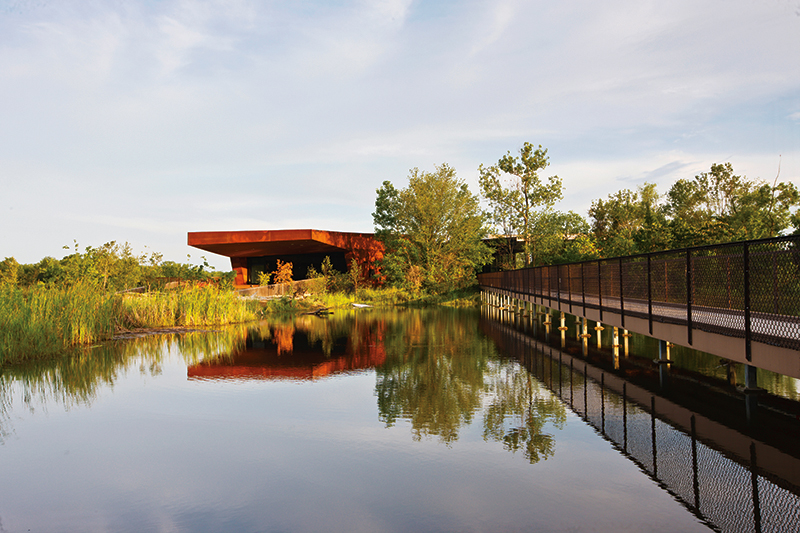
Trinity River Audubon Center in Dallas, the first LEED-certified project for Dallas Park and Recreation Department. Architecture by Antoine Predock & BRW Architects. – photo by Sean Fitzgerald courtesy Trinity River Audubon Center
Over decades, city leaders and designers have trended away from Army Corps-style infrastructure (and tollways) toward human-friendly, nature-based solutions. Through this lens, the swell and meander of the river is a good problem to have: It locks in a tempering greenbelt microclimate in the city’s midst. It is up to design visions as to how the Trinity River Corridor fulfills its potential as a buffer against flooding, green lung, biodiversity engine, and resilient public landscape.
From proposed rewilding concepts to urbanist parks, projects are challenging to pull off in a dense urban setting, but the health dividends and passively efficient control they offer as urban ecologies are unmistakable. Strung together, they have a greater cumulative effect. The Great Trinity River Forest is a 6,200-acre urban pocket of hardwood bottomland southeast of downtown, home to tiered natural communities and recreating human ones. The Dallas Water Commons, currently in development, will provide a northern link to this grand forest and transform a marginal brownfield into a 17-acre green oasis and sustainable urban wetland that naturally and visibly processes water. “The future of cities is linked to water,” says the public-private partnership’s director, Melanie Ferguson. “[The Commons] will provide all three: flood management, conservation, and filtration.” This innovative project exemplifies a paradigm that brings resource metabolism, systemic health, people, and natural beauty together into one cohesive project that also has a relationship with its urban context.
In Berlin …
The waterworks at Potsdamer Platz are a supremely optimistic response to a complex urban condition with a somber history. Berlin’s commercial and cultural center, wiped out by Allied bombing and stagnant through the decades of the Cold War, was entirely rebuilt following the 1989 fall of the Berlin Wall. Within an extensive master plan, landscape architect Herbert Dreiseitl urged a vision for urban waterworks far more ambitious than a public fountain. “I told them to look at water in the context,” says Dreiseitl. “Where is the water coming from, where is it going, and what is the water doing?” Dreiseitl succeeded in his agenda to deeply embed urban ecology into the design of a bustling public space, showcasing the use and cycling of water across an interactive built landscape.
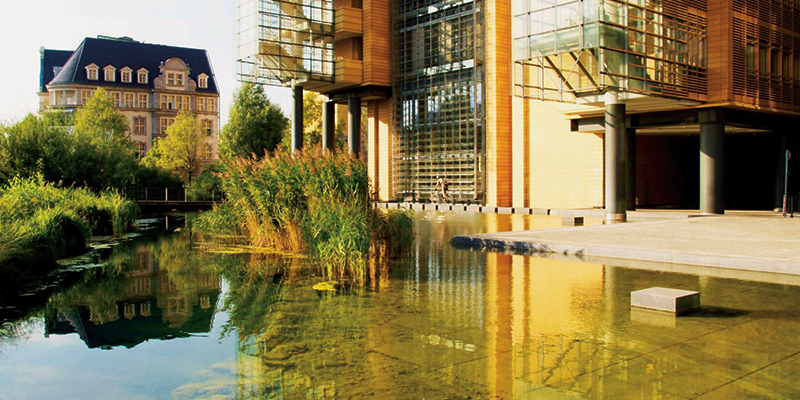
Waterworks, Potsdamer Platz, ©Atelier Dreiseitl/Ramboll
The 3-acre project turned a greyfield into a robust civic space and blue-green infrastructure. With Water Sensitive Urban Design (WSUD) and building-integrated water recycling systems, the cycle begins with rainfall and follows a path both vertically and laterally over layers of building. More than one-third of the project’s rooftop areas are vegetated to provide a first line of capture. Then, shed water continues to large underground cisterns to serve for fire control, irrigation, and toilets. Harvested water also travels to pools and canals that shape a shimmering public waterscape anchored by a small lake and piazza; large storm events overflow to a nearby waterway. Filtration “biotopes” and pumped recirculation maintain consistently high water quality. The project is an ingenious stormwater buffering device, beautifully deployed for public enjoyment while reducing urban heat and healing old city scars.
(Publisher’s Note: See the Potsdamer Platz Project Profile in the Greenroofs.com Projects Database.)
Back in Texas …
The largest and fastest-growing state in the mainland U.S. has a variety of opportunities to implement natural systems solutions throughout its diverse geographies. Projects at a regional scale offer enormous potential for human and nonhuman health and connectivity (the Great Springs Project, connecting major springs along the interstate fault line from Austin to San Antonio, is one), but there are myriad smaller projects already in place available to model and adapt elsewhere. The Festival Beach Food Forest in Austin has transformed city park land into an edible forest garden, cultivating rich soil and community health. The University of Texas at El Paso’s Centennial Plaza gathers stormwater and people in a shady resilient native landscape. Land bridges at San Antonio’s Hardberger Park and Houston’s Memorial Park extend green spaces across divisive vehicular thoroughfares.
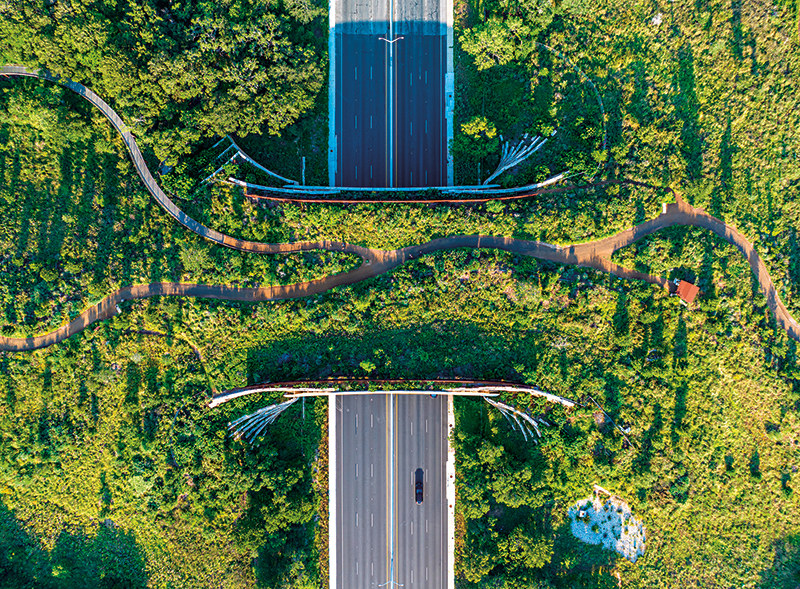
Robert L.B. Tobin Land Bridge and SkyWalk at Phil Hardberger Park, Justin Moore courtesy Phil Hardberger Park
These are localized solutions that clean, infiltrate, cool, heal, and delight, and can be stitched together for greater effect. This is the way we can act and make a difference.
And all that the Lorax left here in this mess / was a small pile of rocks, with the one word … “UNLESS.” —The Lorax, Dr. Seuss
“Time intelligence” allowed cities to grow organically and responsively over centuries. As our ability to radically extract and transform the earth has accelerated urbanization, we must sharpen our wisdom to stem the loss of history, character, and natural systems. The call for urban density is not explicitly a call for higher quantities; it’s a call for a desired condition of urban living. If nature in the city is eroded, we will literally bake quality of life out of our built fabric. So how do we make green density a part of the built density conversation, a reflection of a symbiotic relationship rather than a zero-sum conflict? We can fit more good things into the same space, like filling a closet or nestling plant guilds. We can employ building-integrated green, right-sizing, repurposing, and ecosystem services. We can tap communities of people, the toughest fiber in a city, as an innate strength in collaborating with field experts to produce green-based amenities. We need to listen, holding space for process, especially in redressing inequity. Skillful facilitation is perhaps our new superpower, enabling us to find a “third way.” Synthesizing divergent views is critical to creating a built environment of quality and depth, of surviving and thriving. Telling the story of interconnectedness is where the work starts.
~ Lauren Woodward Stanley
Lauren Woodward Stanley, AIA, is co-owner of Stanley Studio in Austin, Texas.
 Greenroofs.comConnecting the Planet + Living Architecture
Greenroofs.comConnecting the Planet + Living Architecture
